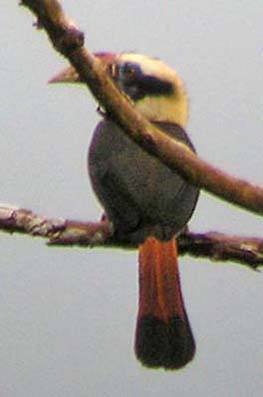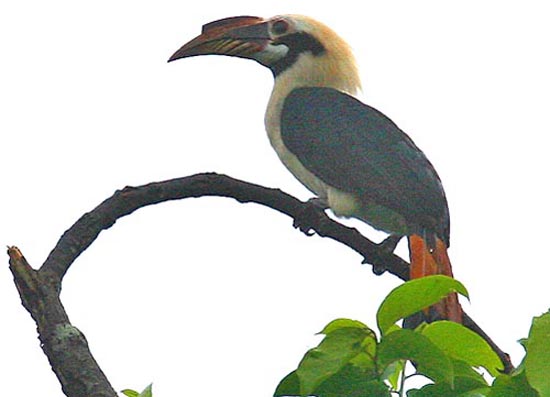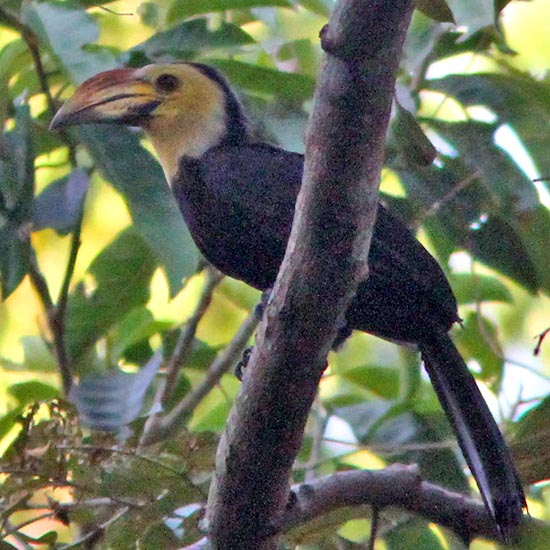
a web page by Don Roberson |
HORNBILLS Bucerotidae |
||||
|
||||
If that was not enough, the heavy whoosh of wings as a big hornbill approaches or leaves in the thick jungle recalls a close encounter with a jet airplane. An encounter with a flying Blyth's Hornbill (below) is like that. And then there is the huge bill, the horny casque, the striking plumage patterns, the long tail .... these are birds to be remembered long after they have moved on. |
||||
 |
||||
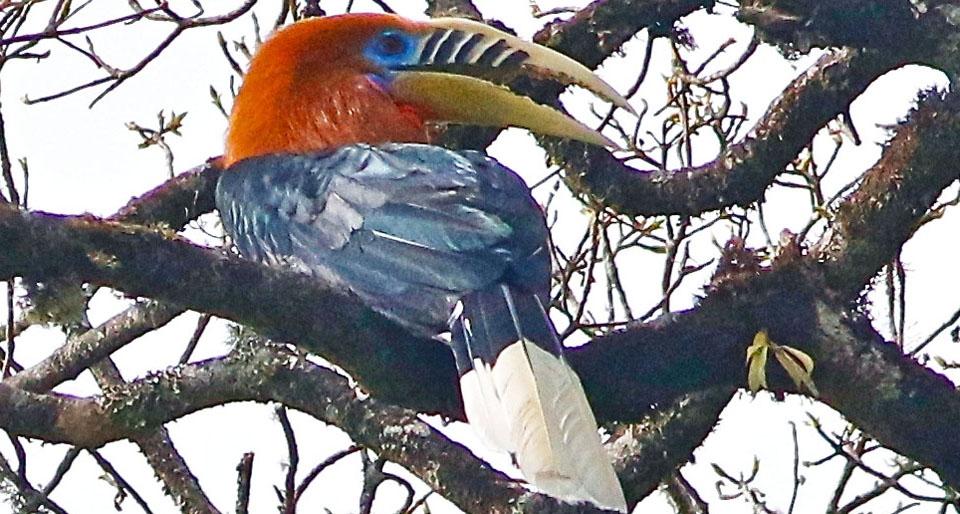 |
||||
And some have incredible calls: those of the Helmeted Hornbill may be the most impressive bird vocalizations in the world: a series of hoots accelerate in speed and intensity until they break into peals of hysterical laughter. What a treat to hear! This is a very distant shot of a male Helmeted Hornbill (below) in Borneo:
Alan Kemp, world authority on this family, must agree, for he begins his Hornbills book (1995) this way: "Imagine being on the tropical island of Borneo and drifting quietly down a stream in a dug-out canoe. The giant trees of the rainforest rise on each bank like cathedral spires, and the creepers which festoon them form cloisters that conceal the dark damp interior. Raindrops pattering on the foliage and distant rumble of a retreating thunderstorm form a backdrop of sound, though, which penetrates a single mournful hoot. More hoots follow at intervals, accelerating in tempo until they break suddenly into peals of maniacal laughter. Two huge birds then burst across the dome of the sky, their naked red heads extended and metre-long tail feathers trailing behind. Cackling loudly, they ram into one another like mountain sheep. . . . Male Helmeted Hornbills are busy in defense of their territorial boundaries."
I have visited two spots on earth that host a great diversity of hornbills, one of them in Asia. Nine species inhabit Danum Valley reserve in the north Borneo lowlands. I saw 7 of these (plus heard the Helmeted) during a 3-day visit in Aug 1988. I was also fortunate to later see the Helmeted in Sumatra, deep in primary forest where I was eventually driven out by attacking leeches! On our Aug 2003 visit to Danum Valley, we saw 8 species, including both the Helmeted and the Rhinoceros. I took a rather bad flight shot of Rhinoceros Hornbill that trip, as it flew over the Kinabatagan River. I've combined it with my habitat shot at the location, and the collage is just below: |
||||
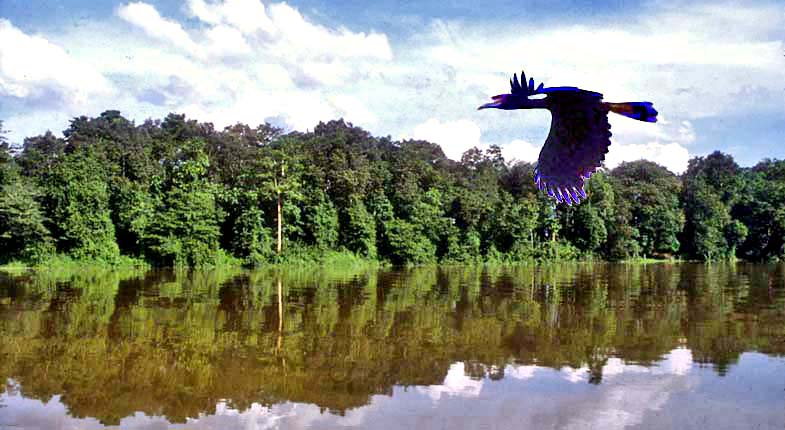 |
||||
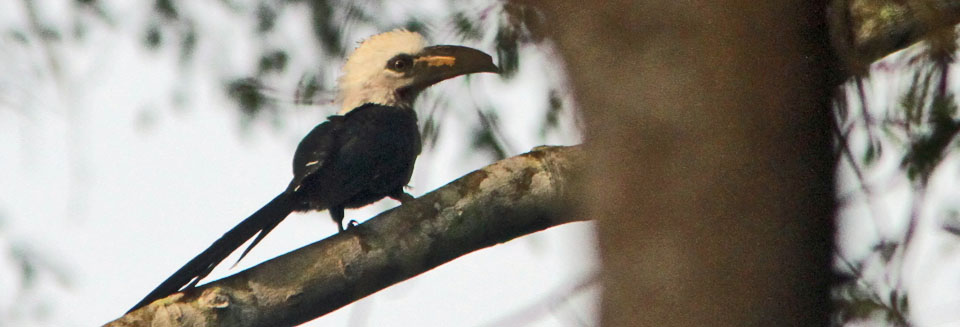 |
||||
Another La Lopé highlight was to find both dwarf hornbills: Red-billed Dwarf Hornbill Lophoceros camurus and Black Dwarf Hornbill (below; photo'd years later from the canopy walk in Ghana's Kakum NP). |
||||
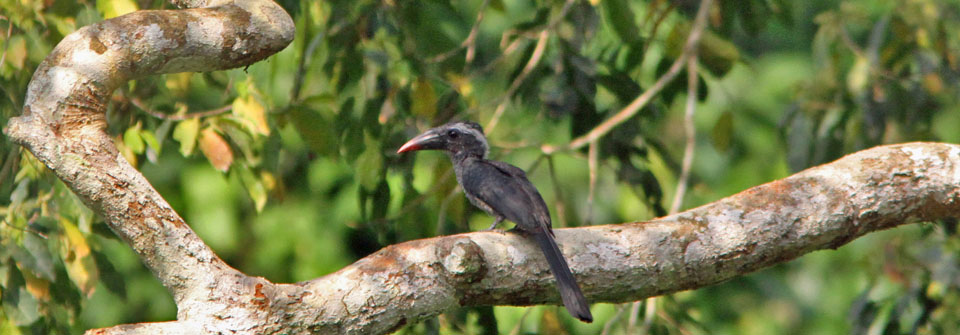 |
||||
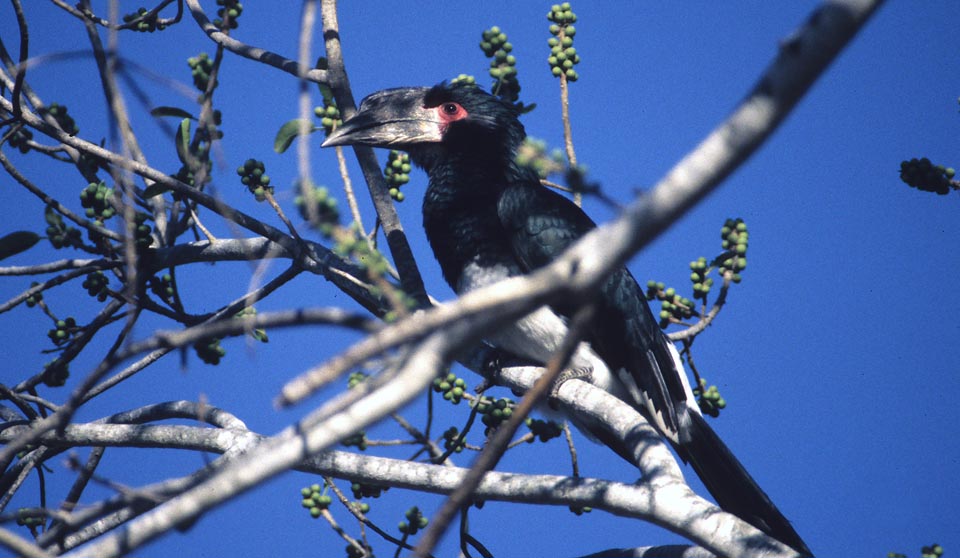 |
||||
The rainforest hornbills are primarily frugivores, but supplement their diet with animal matter (lizards, snakes, arachnids) during nesting. Trumpeter Hornbill is a large species of central and southeastern forests in Africa. The fruits upon which this one has been dining appear the photo (above). Viseshukal et al. (2011) sequenced the cytochrome-b gene and discovered that all clades leading to frugivorous hornbills originated in the mid-Eocene ~48 million years ago. This "explosive radiation coincided with a remarkable floral invasion of Asian rainforests from the Indian microcontinent. Analysis of phylogenetic data, in conjunction with paleontological events, suggests that the invasion of distinctive flora comprised two waves, one during the mid-Eocene, when India was offshore of the Sunda Shelf, and the other late Eocene, when India collided with the Asian mainland. We propose that frugivorous vertebrates, such as hornbills, were present during the first wave and assisted rapid colonization of the Asian flora." In layman's terms, an explosive evolution of trees and shrubs ~48 mya led to rapid diversification in hornbills which, in turn, aided a 'second wave' of Asian floral evolution because the seeds of plants were dispersed widely by hornbills and other vectors (like bats). Viseshukal et al. (2011) also found that all the hornbill genera were ancient lineages of at least 30 million years. [Following Kemp (1995), I consider the Ground-Hornbills to be a separate family. The Handbook of the Birds of the World series (Kemp 2001) kept the two groups together in a single family, as had been the traditional view, but ground-hornbills do no seal the female into a nest site and differ in many other ways, and Kemp noted they should be separate families. Viseshukal et al. (2011) found that ground-hornbills diverged from the rest of the hornbills ~54 million years ago.] When the frugivorous hornbills diverged ~48mya, another evolution line became primarily carnivorous dry-country hornbills. They, too, are actually omnivorous, but they eat insects and vertebrates throughout the year. Africa has a variety of dry-country species in genus Tockus. Southern Yellow-billed Hornbill (below left) is widespread in southern Africa. It can be very tame in parks and game reserves. Von der Decken's Hornbill (below right) occurs in arid savanna of east Africa; the striking red-and-yellow bill makes this a male. |
||||
|
||||
Monteiro's Hornbill (above, both shots: open wing and facing left) is endemic to very arid country in Namibia and sw. Angola, just opposite from the tall, humid, leech-infested forests inhabited by Helmeted Hornbill, of which Alan Kemp wrote in the intro to his book, and quoted above. His very next paragraph in Kemp (1995) sets the stage for Monteiro's: "The thundershower which fell during the night on the mountains bordering the Namib Desert may be the total precipitation for the year. The freshly laundered dawn reveals a flash flood in the previously dry riverbed, but no obvious effect, as yet, on the leafless thorn bushes scattered over the rocky hillsides. A deep clucking call emanates from the valley and provides rhythm to the chorus of singing birds, all excited by the promise of plenty which water brings to their arid land. The clucking call comes from a pair of hornbills, bobbing up and down with each note, bowing their heads and fanning their white outer tail feathers. Their territorial display over, they fly to the riverbed, gather mud in their long red bills, carry it to a cliff, and apply it to the rim of a cavity among the rocks. A pair of Monteiro's Hornbills is wasting no time in preparing to breed." |
||||
This red-billed hornbill (right), digiscoped at dawn in Etosha NP, Namibia, superficially looks like Damara (pale face) but its eye color is a pale hazel, not dark like Damara nor yellow like Southern Red-billed. The location is within the known intergrade zone. So this particular hornbill may actually be an intergrade between the two species within the very narrow hybrid zone in northeast Namibia. |
||||
|
||||
Photos: The pair of Knobbed Hornbill Aceros cassidix were taken in Dumoga-Bone NP, Sulawesi, Indonesia, in Sep 2011. The Blyth's Hornbill A. plicatus was at Foli, Halmahera, Indonesia, in Oct 2011. The male Red-necked Hornbill Aceros nipalensis was at Morong, Bhutan, on 18 Mar 2019. The Great Indian Hornbill Buceros bicornis was in Kaziranga NP, Assam, India, on 13 Mar 2019. The Helmeted Hornbill B. vigil was perched in the far distance at Borneo Rainforest Lodge, Danum Valley, Sabah, Malaysia, in Aug 2002. The flying Rhinoceros Hornbill B. rhinoceros that was photo-shopped into the photo of the Kinabatagan River was in north Borneo, Sabah, Malaysia, in Aug 2002; the massive horny casque atop the bill shows better on the cover of Smythies' Birds of Borneo book. The White-crested Hornbill Horizocerus albocristatus was in the Bobiri Butterfly Reserve, Ghana, on 17 Dec 2013. The Crowned Hornbill Tockus alboterminatus was photographed at Ruhiza in the highlands of the Impenetrable Forest, Uganda, in July 2002. The termite-catching African Pied Hornbill T. fasciatus was east of Makoukou, Gabon, in July 1996. The Black Dwarf Hornbill Horizocerus hartlaubi was seen the canopy walkway in Kakum NP, Ghana, on 2 Dec 2013. The Trumpeter Hornbill Ceratogymna bucinator was in Kruger NP, South Africa, in July 1996. The Southern Yellow-billed Hornbill T. leucomelas was a common bird in Kruger Nat'l Park, South Africa, in July 1996. They fed out of our hands in some picnic areas in the park, and we also watched one following a White Rhinoceros to snatch up whatever the beast disturbed. The male Von der Decken's Hornbill T. deckeni was in Tarangire Nat'l Park, Tanzania, in Aug 2002. The African Gray Hornbill T. nasutus was in Etosha NP, Namibia, on 20 July 2005. The Monteiro's Hornbill T. monteiri was near Erongo Wilderness Lodge, Namibia, on 16 July 2005. The intergarde Southern Red-billed x Damara Red-billed Hornbill was at Halali Camp, Etosha NP, Namibia, on 21 July 2006. The Mindoro Hornbill Penelopides mindorensis was at Siburan, Mindoro, in Dec 2005. Blake Matheson photographed the Mindanao Hornbill P. affinis in the PICOP forest, Mindanao, in Jan 2006. The Sulawesi Hornbill P. exarhatus was in Karenta Forest, southern Sulawesi, in Sep 2011. Photos © Don Roberson, except the Mindanao Hornbill credited to © Blake Matheson, used with permission; all rights reserved. Family book:
Literature cited:
|
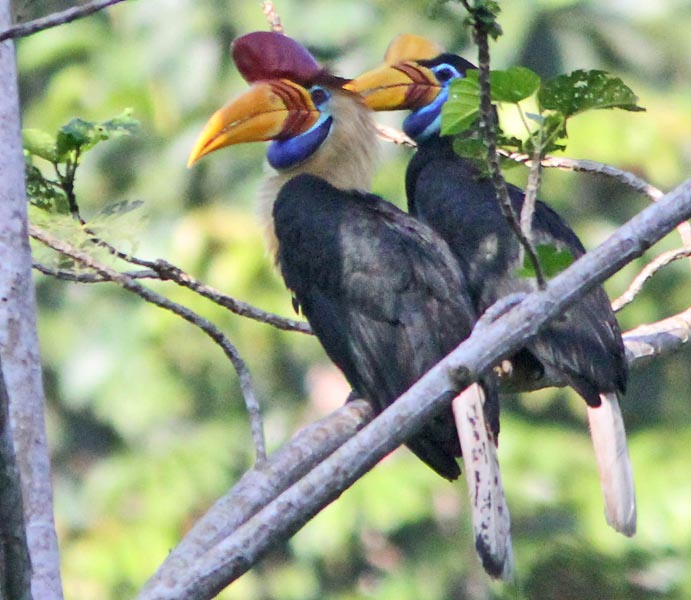 Hornbills are spectacular denizens of the Old World tropics. They range from dense primary forests to dry open savanna, and each species is a dramatic bird. As a group they are right at or near the top of the list of my favorite birds. Having a close encounter with a pair of Knobbed Hornbill (left), for example, is a peak experience. There is the jungle, there are these huge wonderful birds, and there is you.
Hornbills are spectacular denizens of the Old World tropics. They range from dense primary forests to dry open savanna, and each species is a dramatic bird. As a group they are right at or near the top of the list of my favorite birds. Having a close encounter with a pair of Knobbed Hornbill (left), for example, is a peak experience. There is the jungle, there are these huge wonderful birds, and there is you.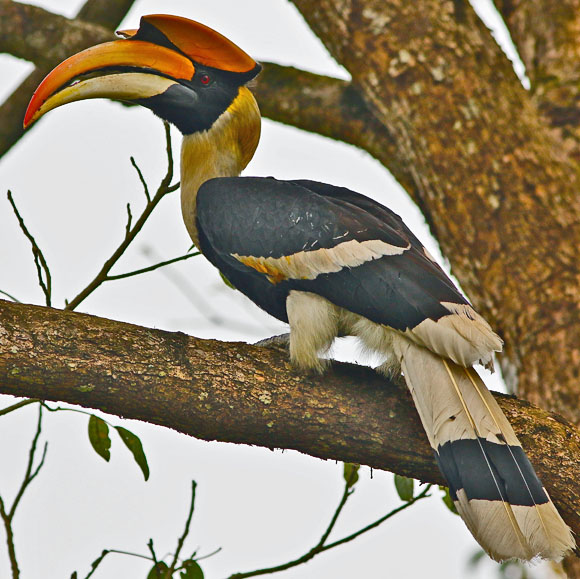 As we shall see below, there are some impressive hornbills in Africa. Yet I will admit that I think of tropical Asia as the "land of the hornbill." So many of the spectacular huge hornbills are here, such as: a stunning male Red-necked Hornbill (above) in Bhutan, or Great Indian Hornbill (left) in in Indian foothills.
As we shall see below, there are some impressive hornbills in Africa. Yet I will admit that I think of tropical Asia as the "land of the hornbill." So many of the spectacular huge hornbills are here, such as: a stunning male Red-necked Hornbill (above) in Bhutan, or Great Indian Hornbill (left) in in Indian foothills.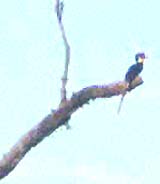
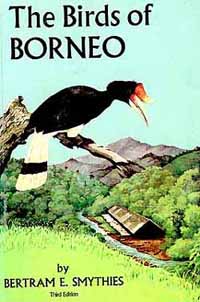 The Great Indian, the maniacal Helmeted, and the huge-billed Rhinoceros are perhaps the most impressive of the hornbills. It is Rhinoceros Hornbill that is featured on the cover of Smythies' (1960) classic Birds of Borneo (right) — a favorite painting of mine.
The Great Indian, the maniacal Helmeted, and the huge-billed Rhinoceros are perhaps the most impressive of the hornbills. It is Rhinoceros Hornbill that is featured on the cover of Smythies' (1960) classic Birds of Borneo (right) — a favorite painting of mine. 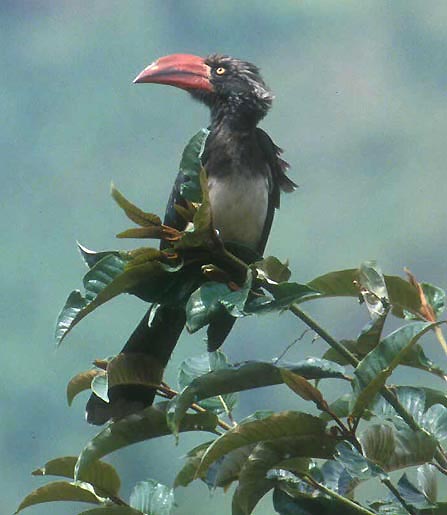 Africa also has impressive forest hornbills. La Lopé Reserve in the Congo Basin of Gabon hosts 8 species. I observed 6 of them in a 3-day visit, including the amazing long-tailed,White-crested Hornbill (above) perched in primary forest. La Lopé it was following a troops of monkeys, presumably to locate fruit or prey. Crowned Hornbill (left) is a widespread but impressive species. This African Pied Hornbill (inset below) was performing aerial loops and dives as it chased hatching termites during a swarm:
Africa also has impressive forest hornbills. La Lopé Reserve in the Congo Basin of Gabon hosts 8 species. I observed 6 of them in a 3-day visit, including the amazing long-tailed,White-crested Hornbill (above) perched in primary forest. La Lopé it was following a troops of monkeys, presumably to locate fruit or prey. Crowned Hornbill (left) is a widespread but impressive species. This African Pied Hornbill (inset below) was performing aerial loops and dives as it chased hatching termites during a swarm: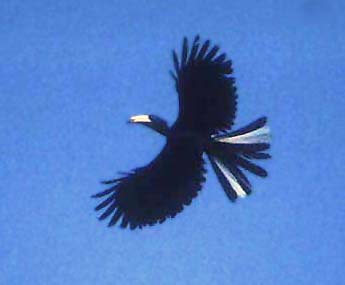
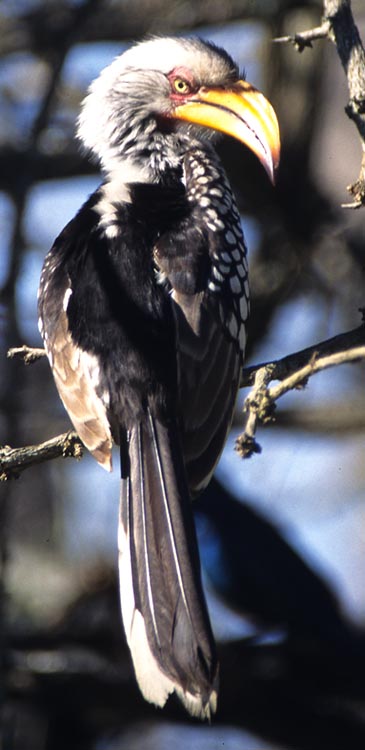

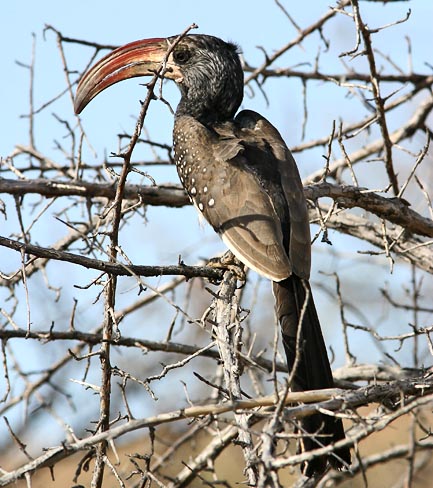 The breeding biology of hornbills, featuring sealing the female inside the nest cavity during incubation while the male feeds her through a tiny slit, is among the strangest of all birds. A fine introduction to the family, with spectacular photos — including the whole nest-sealing procedure and 'inside-the-nest' views — is in Kemp (2001). For the African Gray Hornbill (above), a bird of thorn-forest scrub (as you can see), the nest site is a natural cavity in a tree, or a hole that has been worked on by woodpeckers or barbets, or even the ground holes dug by Red-and-yellow Barbets Trachyphonus erythrocephalus. The female is sealed in for 5-11 days before laying the first egg, and remaining eggs are often laid every-other-day until the clutch of 4-7 is complete. It then takes up to 8 days to hatch a brood of four. The female and youngsters remain sealed up until the eldest chick is about 20-30 days old. During this time the male must supply the female with food through the tiny slit in the seal (Kemp 1995).
The breeding biology of hornbills, featuring sealing the female inside the nest cavity during incubation while the male feeds her through a tiny slit, is among the strangest of all birds. A fine introduction to the family, with spectacular photos — including the whole nest-sealing procedure and 'inside-the-nest' views — is in Kemp (2001). For the African Gray Hornbill (above), a bird of thorn-forest scrub (as you can see), the nest site is a natural cavity in a tree, or a hole that has been worked on by woodpeckers or barbets, or even the ground holes dug by Red-and-yellow Barbets Trachyphonus erythrocephalus. The female is sealed in for 5-11 days before laying the first egg, and remaining eggs are often laid every-other-day until the clutch of 4-7 is complete. It then takes up to 8 days to hatch a brood of four. The female and youngsters remain sealed up until the eldest chick is about 20-30 days old. During this time the male must supply the female with food through the tiny slit in the seal (Kemp 1995). 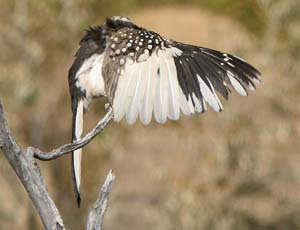
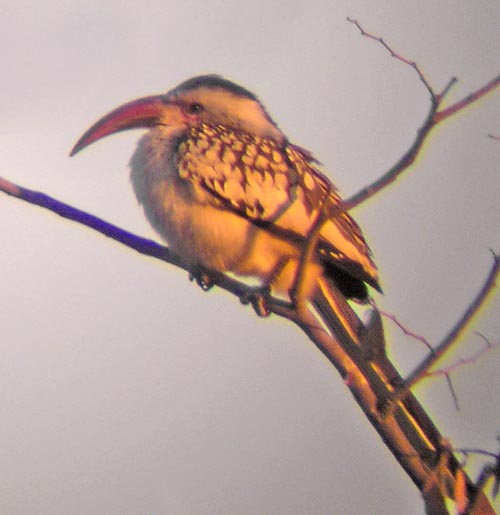 The African hornbills of arid scrubthorn and savannas have interesting taxonomic issues. Populations of Red-billed Hornbill Tockus erythrorhynchus — once considered a continent-wide species — have differing habitats, soft part colors, calls, and courtship behaviors (Kemp & Delport 2002). Where the populations meet there are only very narrow hybrid zones (Delport et al. 2004). These studies have served to split Red-billed Hornbill into five species, including a newly described species — Tanzanian Red-billed Hornbill T. ruahae — limited in range to parts of Tanzania (mostly central & southern Tanzania, but recent records north to Serengeti; Adam Riley, in litt.). The other splits are Northern Red-billed Hornbill T. erythrorhynchus (widespread in east Africa, and also occurs in the Serengeti in n. Tanzania), Damara Red-billed Hornbill T. damarensis (limited to n. Namibia & s. Angola), Southern Red-billed Hornbill T. rufirostris, and Western Red-billed Hornbill T. kempi (in west Africa; named after Alan Kemp).
The African hornbills of arid scrubthorn and savannas have interesting taxonomic issues. Populations of Red-billed Hornbill Tockus erythrorhynchus — once considered a continent-wide species — have differing habitats, soft part colors, calls, and courtship behaviors (Kemp & Delport 2002). Where the populations meet there are only very narrow hybrid zones (Delport et al. 2004). These studies have served to split Red-billed Hornbill into five species, including a newly described species — Tanzanian Red-billed Hornbill T. ruahae — limited in range to parts of Tanzania (mostly central & southern Tanzania, but recent records north to Serengeti; Adam Riley, in litt.). The other splits are Northern Red-billed Hornbill T. erythrorhynchus (widespread in east Africa, and also occurs in the Serengeti in n. Tanzania), Damara Red-billed Hornbill T. damarensis (limited to n. Namibia & s. Angola), Southern Red-billed Hornbill T. rufirostris, and Western Red-billed Hornbill T. kempi (in west Africa; named after Alan Kemp). 